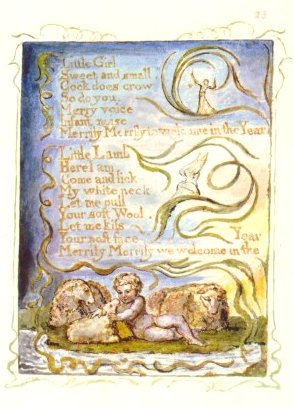 Blake was making a variety of statements through his method of publication. One was a political statement of his opposition to the advent of the machine age which meant the loss of individual production of hand crafted goods. He chose the tedious labor of hand production as a means of entering into the crafting of each item as an expression of his own imagination. If Golgoonoza, Blake's city of imagination existed in London, its headquarters were in the home workshop of William and Catherine Blake - be it ever so humble.
Blake was making a variety of statements through his method of publication. One was a political statement of his opposition to the advent of the machine age which meant the loss of individual production of hand crafted goods. He chose the tedious labor of hand production as a means of entering into the crafting of each item as an expression of his own imagination. If Golgoonoza, Blake's city of imagination existed in London, its headquarters were in the home workshop of William and Catherine Blake - be it ever so humble.Michael Bedard's biography, William Blake The Gates of Paradise, includes this statement about Blake's choosing his nonconformist way of working.
"In rejecting the ways of the world of commerce and the spread of machine methods into the world of art, Blake embraced the Illuminated Book with renewed passion. While industrial production prided itself on the ability to make an endless stream of identical copies, in Illuminated Printing each copy was unique. While industry prided itself on speed and efficiency, Blake's mode of production was deliberately slow and inefficient. While industrial production was grounded on the division of labor and the distinction of those who worked with their heads and those who worked with their hands, Blake's was an artisan's spirit. He took pride in the work of his head and hands and relentlessly pursued the unity of head and hands in the work of art. With the Illuminated Book, Blake strove to restore writing to the 'wondrous art' it was." (Page 140)
Jerusalem , Plate 65, (E 216)
"And all the Arts of Life. they changd into the Arts of Death in Albion.
The hour-glass contemnd because its simple workmanship.
Was like the workmanship of the plowman, & the water wheel,
That raises water into cisterns: broken & burnd with fire:
Because its workmanship. was like the workmanship of the shepherd.
And in their stead, intricate wheels invented, wheel without wheel:
To perplex youth in their outgoings, & to bind to labours in Albion
Of day & night the myriads of eternity that they may grind
And polish brass & iron hour after hour laborious task!
Kept ignorant of its use, that they might spend the days of wisdom
In sorrowful drudgery, to obtain a scanty pittance of bread:
In ignorance to view a small portion & think that All,
And call it Demonstration: blind to all the simple rules of life."
One who chooses the building of Jerusalem as one's lifework is outside of the mainstream of culture in any age.
No comments:
Post a Comment